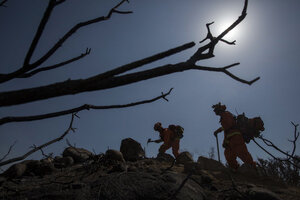California wildfire: 1,900 on the lines as firefighters labor to limit damage
Saturday's more favorable weather and the heroic work of 1,900 firefighters have limited damage from a fast-breaking California wildfire in Ventura County. State outlook is for an active fire season; elsewhere in the US conditions are less ominous.

Hand crews work on the fire line after a wildfire near Point Mugu, Calif., Saturday. On Saturday, high winds and withering hot, dry air were replaced by the normal flow of damp air off the Pacific, significantly reducing fire activity.
Ringo H.W. Chiu/AP
After the monstrous Springs Fire in California's Ventura County tripled in size Friday, firefighters battled the blaze to 30 percent containment on Saturday, helped by the approach of cooler, wetter conditions battening down the flames.
The fire threatened some 4,000 homes as it consumed 43 squares miles on the western slope of the Santa Monica Mountains, at one point with flames racing all the way to the Pacific Coast Highway. No deaths or injuries have been reported. Some 15 homes have been slightly damaged, but improving weather conditions, the yeoman work of some 1,900 firefighters, and fire-dampening preparations by homeowners have limited more widespread damage so far.
The National Weather Service predicted cooler temperatures, more settled winds, higher humidity, and a 20 percent chance of rain going into Sunday, which should continue to help firefighters lay breaks and contain larger portions of the blaze.
“The fire is really laying down,” said Tom Kruschke, a Ventura County Fire Department spokesman.
For Californians, such a large fire nearly a month before the official kick-off of the wildfire season is ominous, especially as the National Interagency Fire Service on May 1 predicted a wildfire season of above-normal intensity in both southern and northern California.
Dry conditions abound, making fires easier to ignite, but drought has also stunted undergrowth, limiting potential fire fuel, the fire service reported.
As it stands, even an active fire season would struggle to compete with that of 2012, which nationally burned more than 9 million acres, much of it in Colorado, and of 2011, which saw record wildfires sweep across drought-ravaged Texas, destroying hundreds of homes and burning at least 4 million acres in the Lone Star State alone.
While spreading drought conditions in California have meant a 20 percent jump so far in the number of wildfires, an unusually cold, wet spring across the US has come as a relief for the US firefighting corps, which has spent the past few wildfire seasons on full alert.
At least some of that cooler weather struck Ventura County after record high temperatures baked the area on Friday.
"We're getting much more favorable weather conditions here. We don't have the high winds and the high temperatures," Mr. Kruschke told reporters.
Forecasters had originally predicted a warmer-than-normal spring across much of the US, but instead the country has witnessed record coolness and wetness, especially east of the Rocky Mountains, where wildfire predictions are now for below-normal chances of significant fires.
Colorado, where the Waldo Canyon Fire last year burned 356 homes and caused the evacuation of 32,000 people near Colorado Springs, is expected to have a lower chance of catastrophic fires, thanks to late-season snows soaking into the ground and moistening the emerging greenery.
But as with other parts of the far West, dry conditions and a smaller snowpack in California have drawn warnings about the potential for an active season. Already, several fires have sparked up weeks ahead of the normal wildfire season, which begins in late May and runs through fall. California smokejumpers have spent the past few weeks battling a series of smaller wildfires, primarily in rough, remote terrain.
“Current climate projections … indicate higher possibilities of warmer than normal conditions for much of the West and cooler than normal across the Plains and the mid- and lower Mississippi Valley,” according to the National Interagency Fire Center. “Temperatures for June through August are expected to be above normal for most of the US. Precipitation is expected to remain near median with pockets of below median precipitation over the Northwest and the southern Plains.”
Forecasters acknowledged their limitations, however, saying that “coupled with other global circulation patterns, there is no clear signal of how long-term weather patterns will evolve this summer.”
“Insurers could see fires of similar magnitude [to the Springs Fire] this season but for now, it’s simply too early to tell,” writes Christina Bramlet of the website Property Casualty 360.

